COM646 - Process Improvement: Analysis of Peer Review Process
VerifiedAdded on 2022/08/25
|8
|1867
|29
Report
AI Summary
This report provides a comprehensive analysis of a peer review process, aiming to identify and address its weaknesses to improve efficiency and quality. The report begins with an introduction outlining the context of the peer review process and its importance in ensuring the accuracy and reliability of published works. It then offers a series of suggestions for improvement, drawing on the Goal-Question-Metric approach and the Six Sigma DMAIC model. The suggestions include refining reviewer selection, establishing formal agreements, clarifying the number of reviewers, enhancing transparency, and facilitating communication between authors and reviewers. The report then presents a Goal-Question-Metric table and a CMMI process model to further structure and guide the improvement efforts. A reflection section applies the Six Sigma DMAIC model, detailing how each phase of the model was used to identify, measure, analyze, improve, and control the peer review process. The conclusion emphasizes the effectiveness of process management in identifying and resolving process issues, with the CMMI model supporting the development of improvement suggestions. The report uses references to support all suggestions and findings.
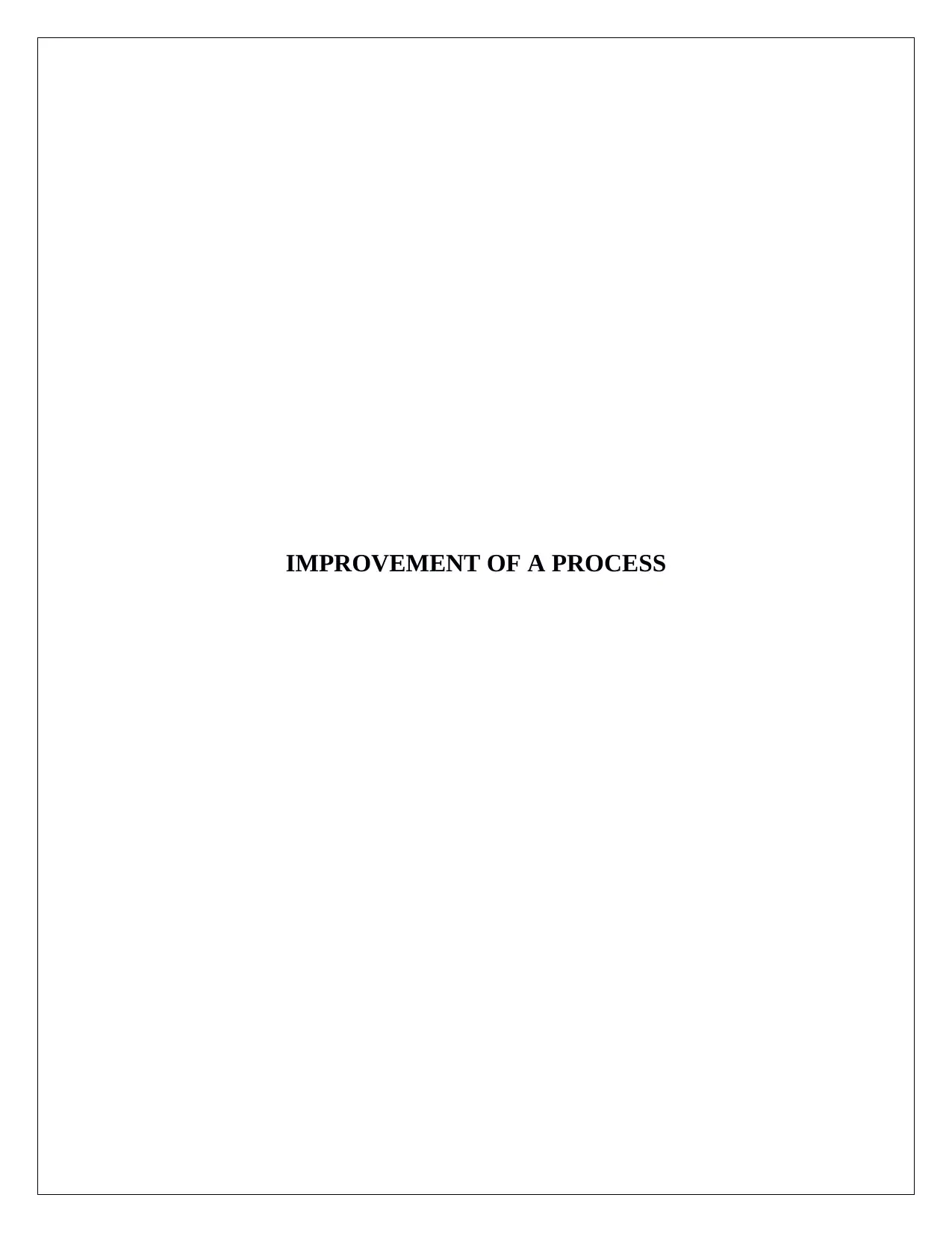
IMPROVEMENT OF A PROCESS
Paraphrase This Document
Need a fresh take? Get an instant paraphrase of this document with our AI Paraphraser
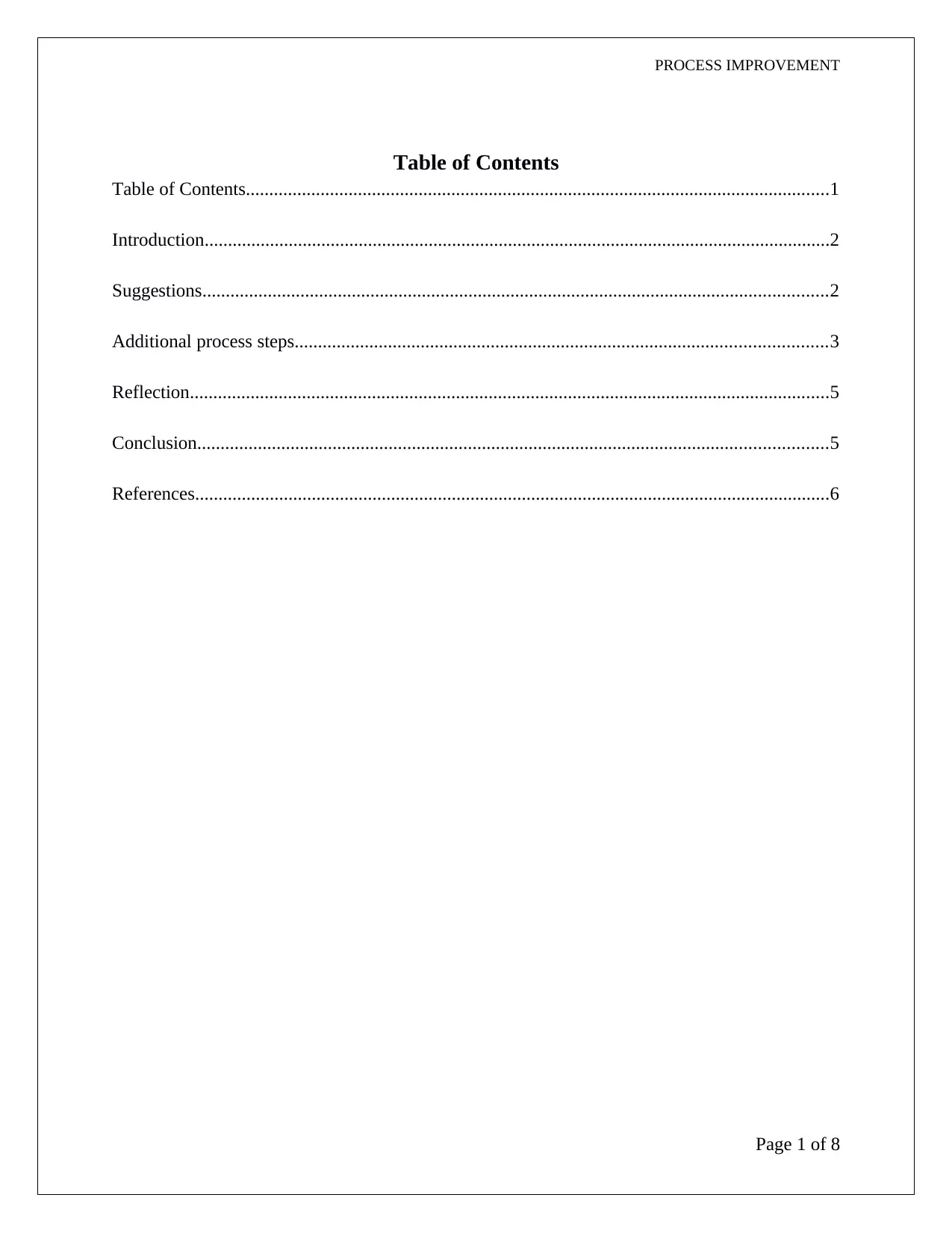
PROCESS IMPROVEMENT
Table of Contents
Table of Contents.............................................................................................................................1
Introduction......................................................................................................................................2
Suggestions......................................................................................................................................2
Additional process steps..................................................................................................................3
Reflection.........................................................................................................................................5
Conclusion.......................................................................................................................................5
References........................................................................................................................................6
Page 1 of 8
Table of Contents
Table of Contents.............................................................................................................................1
Introduction......................................................................................................................................2
Suggestions......................................................................................................................................2
Additional process steps..................................................................................................................3
Reflection.........................................................................................................................................5
Conclusion.......................................................................................................................................5
References........................................................................................................................................6
Page 1 of 8
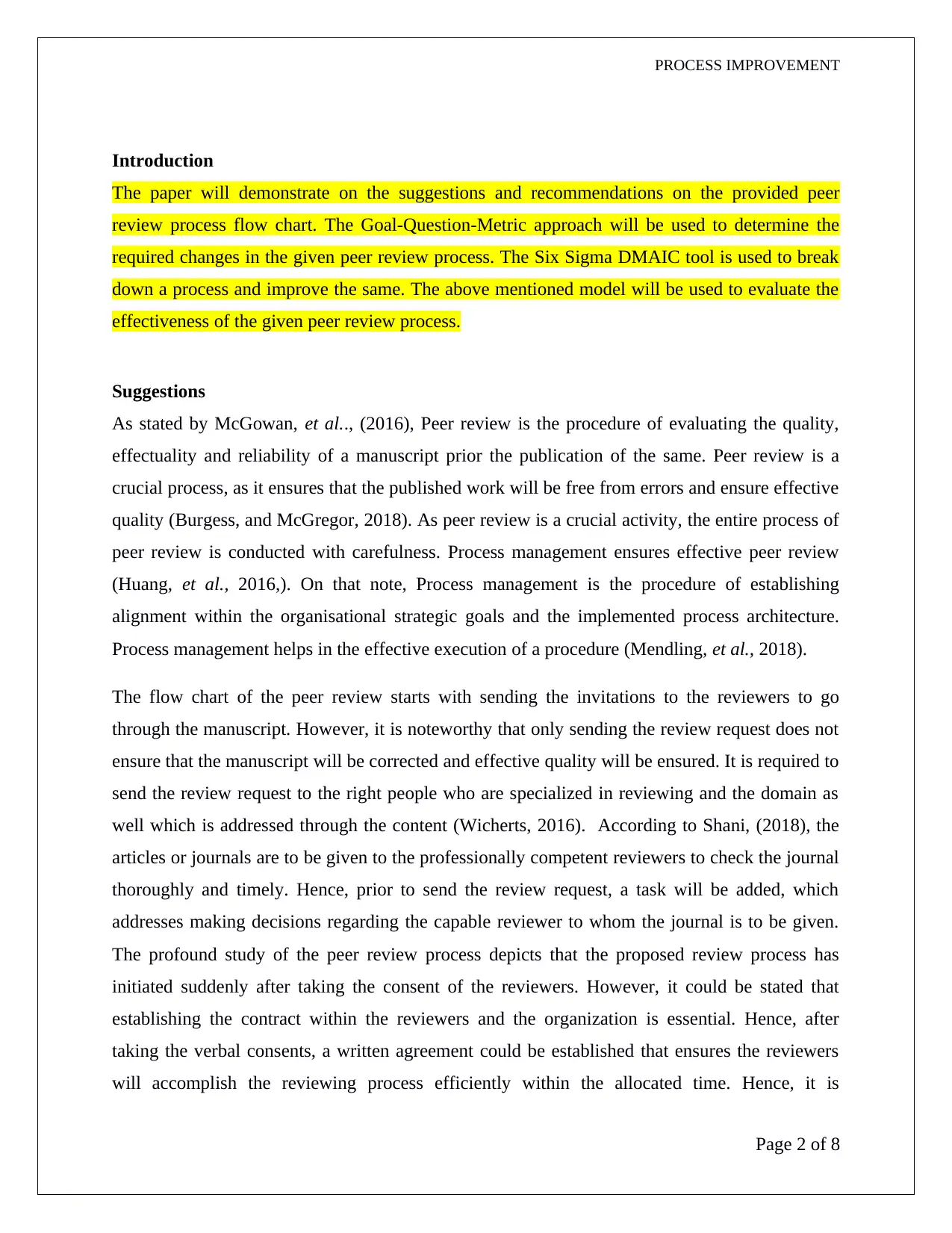
PROCESS IMPROVEMENT
Introduction
The paper will demonstrate on the suggestions and recommendations on the provided peer
review process flow chart. The Goal-Question-Metric approach will be used to determine the
required changes in the given peer review process. The Six Sigma DMAIC tool is used to break
down a process and improve the same. The above mentioned model will be used to evaluate the
effectiveness of the given peer review process.
Suggestions
As stated by McGowan, et al.., (2016), Peer review is the procedure of evaluating the quality,
effectuality and reliability of a manuscript prior the publication of the same. Peer review is a
crucial process, as it ensures that the published work will be free from errors and ensure effective
quality (Burgess, and McGregor, 2018). As peer review is a crucial activity, the entire process of
peer review is conducted with carefulness. Process management ensures effective peer review
(Huang, et al., 2016,). On that note, Process management is the procedure of establishing
alignment within the organisational strategic goals and the implemented process architecture.
Process management helps in the effective execution of a procedure (Mendling, et al., 2018).
The flow chart of the peer review starts with sending the invitations to the reviewers to go
through the manuscript. However, it is noteworthy that only sending the review request does not
ensure that the manuscript will be corrected and effective quality will be ensured. It is required to
send the review request to the right people who are specialized in reviewing and the domain as
well which is addressed through the content (Wicherts, 2016). According to Shani, (2018), the
articles or journals are to be given to the professionally competent reviewers to check the journal
thoroughly and timely. Hence, prior to send the review request, a task will be added, which
addresses making decisions regarding the capable reviewer to whom the journal is to be given.
The profound study of the peer review process depicts that the proposed review process has
initiated suddenly after taking the consent of the reviewers. However, it could be stated that
establishing the contract within the reviewers and the organization is essential. Hence, after
taking the verbal consents, a written agreement could be established that ensures the reviewers
will accomplish the reviewing process efficiently within the allocated time. Hence, it is
Page 2 of 8
Introduction
The paper will demonstrate on the suggestions and recommendations on the provided peer
review process flow chart. The Goal-Question-Metric approach will be used to determine the
required changes in the given peer review process. The Six Sigma DMAIC tool is used to break
down a process and improve the same. The above mentioned model will be used to evaluate the
effectiveness of the given peer review process.
Suggestions
As stated by McGowan, et al.., (2016), Peer review is the procedure of evaluating the quality,
effectuality and reliability of a manuscript prior the publication of the same. Peer review is a
crucial process, as it ensures that the published work will be free from errors and ensure effective
quality (Burgess, and McGregor, 2018). As peer review is a crucial activity, the entire process of
peer review is conducted with carefulness. Process management ensures effective peer review
(Huang, et al., 2016,). On that note, Process management is the procedure of establishing
alignment within the organisational strategic goals and the implemented process architecture.
Process management helps in the effective execution of a procedure (Mendling, et al., 2018).
The flow chart of the peer review starts with sending the invitations to the reviewers to go
through the manuscript. However, it is noteworthy that only sending the review request does not
ensure that the manuscript will be corrected and effective quality will be ensured. It is required to
send the review request to the right people who are specialized in reviewing and the domain as
well which is addressed through the content (Wicherts, 2016). According to Shani, (2018), the
articles or journals are to be given to the professionally competent reviewers to check the journal
thoroughly and timely. Hence, prior to send the review request, a task will be added, which
addresses making decisions regarding the capable reviewer to whom the journal is to be given.
The profound study of the peer review process depicts that the proposed review process has
initiated suddenly after taking the consent of the reviewers. However, it could be stated that
establishing the contract within the reviewers and the organization is essential. Hence, after
taking the verbal consents, a written agreement could be established that ensures the reviewers
will accomplish the reviewing process efficiently within the allocated time. Hence, it is
Page 2 of 8
⊘ This is a preview!⊘
Do you want full access?
Subscribe today to unlock all pages.

Trusted by 1+ million students worldwide
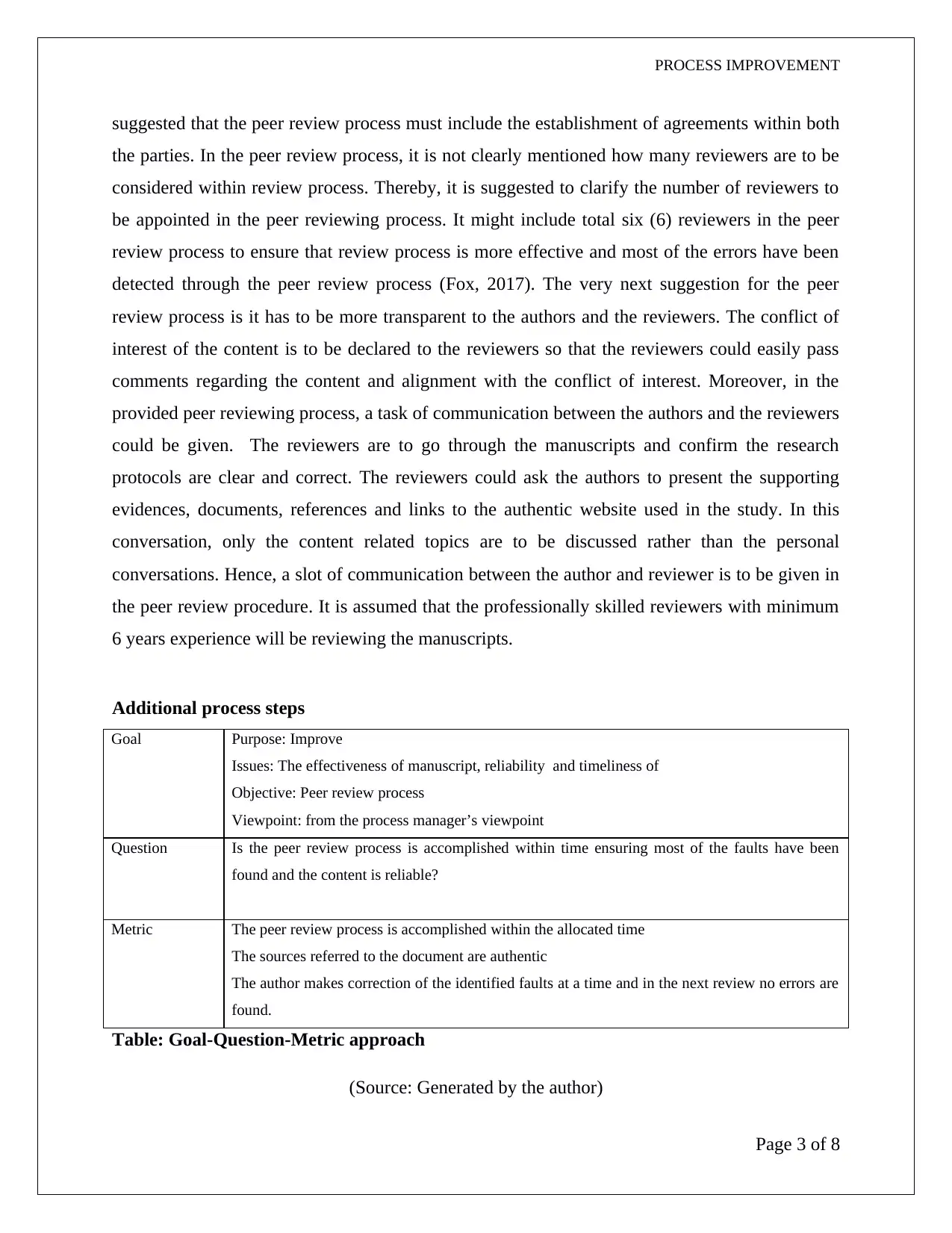
PROCESS IMPROVEMENT
suggested that the peer review process must include the establishment of agreements within both
the parties. In the peer review process, it is not clearly mentioned how many reviewers are to be
considered within review process. Thereby, it is suggested to clarify the number of reviewers to
be appointed in the peer reviewing process. It might include total six (6) reviewers in the peer
review process to ensure that review process is more effective and most of the errors have been
detected through the peer review process (Fox, 2017). The very next suggestion for the peer
review process is it has to be more transparent to the authors and the reviewers. The conflict of
interest of the content is to be declared to the reviewers so that the reviewers could easily pass
comments regarding the content and alignment with the conflict of interest. Moreover, in the
provided peer reviewing process, a task of communication between the authors and the reviewers
could be given. The reviewers are to go through the manuscripts and confirm the research
protocols are clear and correct. The reviewers could ask the authors to present the supporting
evidences, documents, references and links to the authentic website used in the study. In this
conversation, only the content related topics are to be discussed rather than the personal
conversations. Hence, a slot of communication between the author and reviewer is to be given in
the peer review procedure. It is assumed that the professionally skilled reviewers with minimum
6 years experience will be reviewing the manuscripts.
Additional process steps
Goal Purpose: Improve
Issues: The effectiveness of manuscript, reliability and timeliness of
Objective: Peer review process
Viewpoint: from the process manager’s viewpoint
Question Is the peer review process is accomplished within time ensuring most of the faults have been
found and the content is reliable?
Metric The peer review process is accomplished within the allocated time
The sources referred to the document are authentic
The author makes correction of the identified faults at a time and in the next review no errors are
found.
Table: Goal-Question-Metric approach
(Source: Generated by the author)
Page 3 of 8
suggested that the peer review process must include the establishment of agreements within both
the parties. In the peer review process, it is not clearly mentioned how many reviewers are to be
considered within review process. Thereby, it is suggested to clarify the number of reviewers to
be appointed in the peer reviewing process. It might include total six (6) reviewers in the peer
review process to ensure that review process is more effective and most of the errors have been
detected through the peer review process (Fox, 2017). The very next suggestion for the peer
review process is it has to be more transparent to the authors and the reviewers. The conflict of
interest of the content is to be declared to the reviewers so that the reviewers could easily pass
comments regarding the content and alignment with the conflict of interest. Moreover, in the
provided peer reviewing process, a task of communication between the authors and the reviewers
could be given. The reviewers are to go through the manuscripts and confirm the research
protocols are clear and correct. The reviewers could ask the authors to present the supporting
evidences, documents, references and links to the authentic website used in the study. In this
conversation, only the content related topics are to be discussed rather than the personal
conversations. Hence, a slot of communication between the author and reviewer is to be given in
the peer review procedure. It is assumed that the professionally skilled reviewers with minimum
6 years experience will be reviewing the manuscripts.
Additional process steps
Goal Purpose: Improve
Issues: The effectiveness of manuscript, reliability and timeliness of
Objective: Peer review process
Viewpoint: from the process manager’s viewpoint
Question Is the peer review process is accomplished within time ensuring most of the faults have been
found and the content is reliable?
Metric The peer review process is accomplished within the allocated time
The sources referred to the document are authentic
The author makes correction of the identified faults at a time and in the next review no errors are
found.
Table: Goal-Question-Metric approach
(Source: Generated by the author)
Page 3 of 8
Paraphrase This Document
Need a fresh take? Get an instant paraphrase of this document with our AI Paraphraser
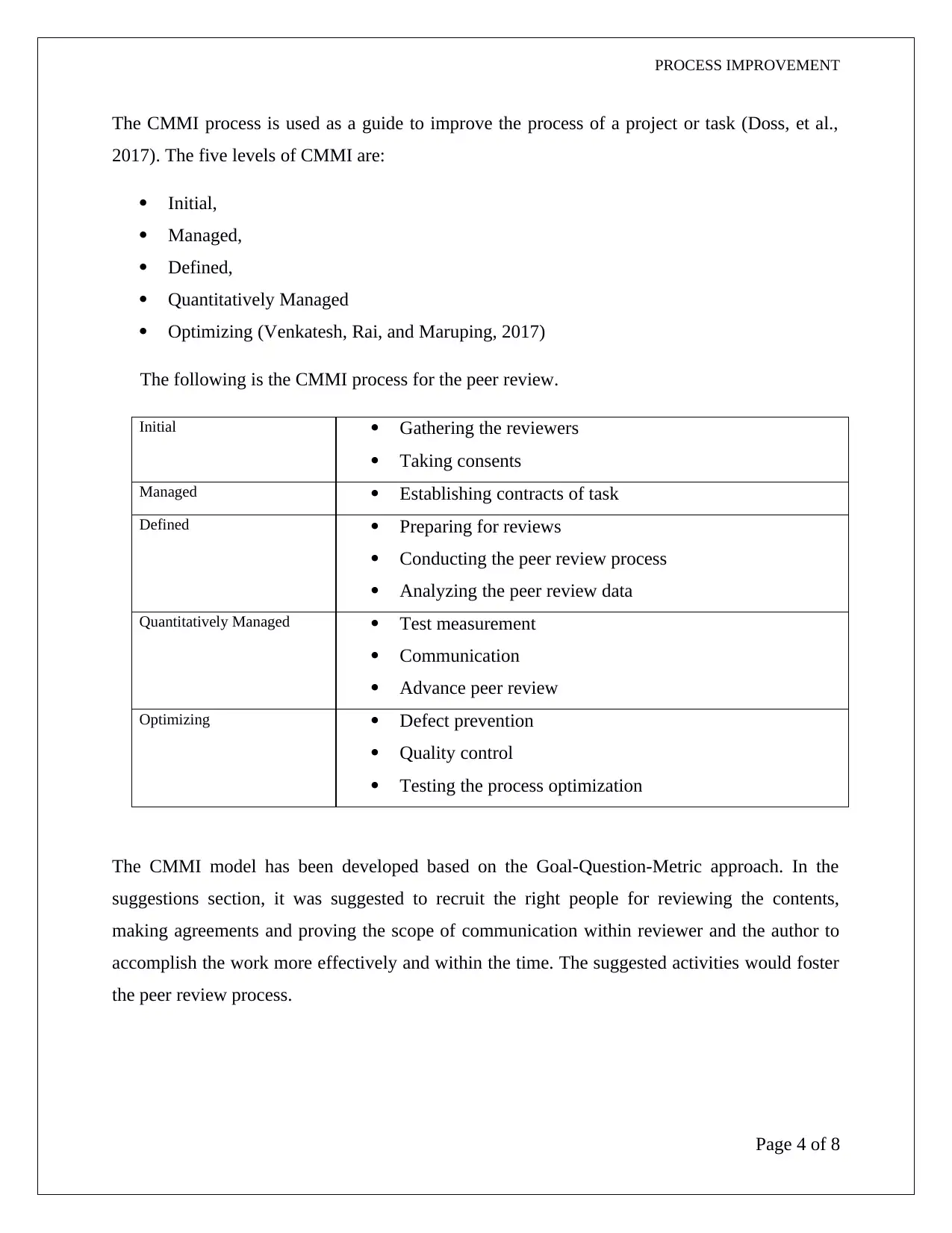
PROCESS IMPROVEMENT
The CMMI process is used as a guide to improve the process of a project or task (Doss, et al.,
2017). The five levels of CMMI are:
Initial,
Managed,
Defined,
Quantitatively Managed
Optimizing (Venkatesh, Rai, and Maruping, 2017)
The following is the CMMI process for the peer review.
Initial Gathering the reviewers
Taking consents
Managed Establishing contracts of task
Defined Preparing for reviews
Conducting the peer review process
Analyzing the peer review data
Quantitatively Managed Test measurement
Communication
Advance peer review
Optimizing Defect prevention
Quality control
Testing the process optimization
The CMMI model has been developed based on the Goal-Question-Metric approach. In the
suggestions section, it was suggested to recruit the right people for reviewing the contents,
making agreements and proving the scope of communication within reviewer and the author to
accomplish the work more effectively and within the time. The suggested activities would foster
the peer review process.
Page 4 of 8
The CMMI process is used as a guide to improve the process of a project or task (Doss, et al.,
2017). The five levels of CMMI are:
Initial,
Managed,
Defined,
Quantitatively Managed
Optimizing (Venkatesh, Rai, and Maruping, 2017)
The following is the CMMI process for the peer review.
Initial Gathering the reviewers
Taking consents
Managed Establishing contracts of task
Defined Preparing for reviews
Conducting the peer review process
Analyzing the peer review data
Quantitatively Managed Test measurement
Communication
Advance peer review
Optimizing Defect prevention
Quality control
Testing the process optimization
The CMMI model has been developed based on the Goal-Question-Metric approach. In the
suggestions section, it was suggested to recruit the right people for reviewing the contents,
making agreements and proving the scope of communication within reviewer and the author to
accomplish the work more effectively and within the time. The suggested activities would foster
the peer review process.
Page 4 of 8
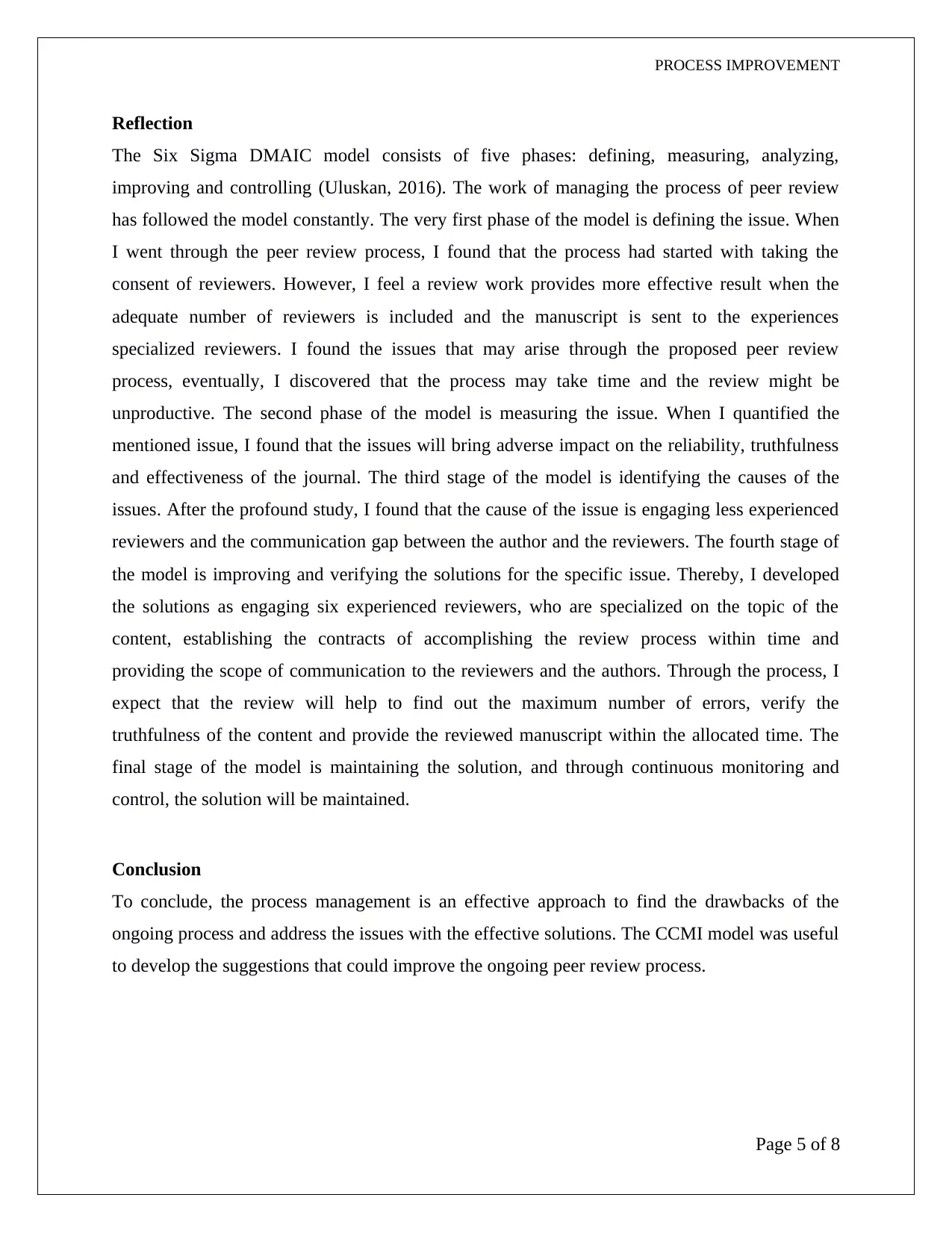
PROCESS IMPROVEMENT
Reflection
The Six Sigma DMAIC model consists of five phases: defining, measuring, analyzing,
improving and controlling (Uluskan, 2016). The work of managing the process of peer review
has followed the model constantly. The very first phase of the model is defining the issue. When
I went through the peer review process, I found that the process had started with taking the
consent of reviewers. However, I feel a review work provides more effective result when the
adequate number of reviewers is included and the manuscript is sent to the experiences
specialized reviewers. I found the issues that may arise through the proposed peer review
process, eventually, I discovered that the process may take time and the review might be
unproductive. The second phase of the model is measuring the issue. When I quantified the
mentioned issue, I found that the issues will bring adverse impact on the reliability, truthfulness
and effectiveness of the journal. The third stage of the model is identifying the causes of the
issues. After the profound study, I found that the cause of the issue is engaging less experienced
reviewers and the communication gap between the author and the reviewers. The fourth stage of
the model is improving and verifying the solutions for the specific issue. Thereby, I developed
the solutions as engaging six experienced reviewers, who are specialized on the topic of the
content, establishing the contracts of accomplishing the review process within time and
providing the scope of communication to the reviewers and the authors. Through the process, I
expect that the review will help to find out the maximum number of errors, verify the
truthfulness of the content and provide the reviewed manuscript within the allocated time. The
final stage of the model is maintaining the solution, and through continuous monitoring and
control, the solution will be maintained.
Conclusion
To conclude, the process management is an effective approach to find the drawbacks of the
ongoing process and address the issues with the effective solutions. The CCMI model was useful
to develop the suggestions that could improve the ongoing peer review process.
Page 5 of 8
Reflection
The Six Sigma DMAIC model consists of five phases: defining, measuring, analyzing,
improving and controlling (Uluskan, 2016). The work of managing the process of peer review
has followed the model constantly. The very first phase of the model is defining the issue. When
I went through the peer review process, I found that the process had started with taking the
consent of reviewers. However, I feel a review work provides more effective result when the
adequate number of reviewers is included and the manuscript is sent to the experiences
specialized reviewers. I found the issues that may arise through the proposed peer review
process, eventually, I discovered that the process may take time and the review might be
unproductive. The second phase of the model is measuring the issue. When I quantified the
mentioned issue, I found that the issues will bring adverse impact on the reliability, truthfulness
and effectiveness of the journal. The third stage of the model is identifying the causes of the
issues. After the profound study, I found that the cause of the issue is engaging less experienced
reviewers and the communication gap between the author and the reviewers. The fourth stage of
the model is improving and verifying the solutions for the specific issue. Thereby, I developed
the solutions as engaging six experienced reviewers, who are specialized on the topic of the
content, establishing the contracts of accomplishing the review process within time and
providing the scope of communication to the reviewers and the authors. Through the process, I
expect that the review will help to find out the maximum number of errors, verify the
truthfulness of the content and provide the reviewed manuscript within the allocated time. The
final stage of the model is maintaining the solution, and through continuous monitoring and
control, the solution will be maintained.
Conclusion
To conclude, the process management is an effective approach to find the drawbacks of the
ongoing process and address the issues with the effective solutions. The CCMI model was useful
to develop the suggestions that could improve the ongoing peer review process.
Page 5 of 8
⊘ This is a preview!⊘
Do you want full access?
Subscribe today to unlock all pages.

Trusted by 1+ million students worldwide
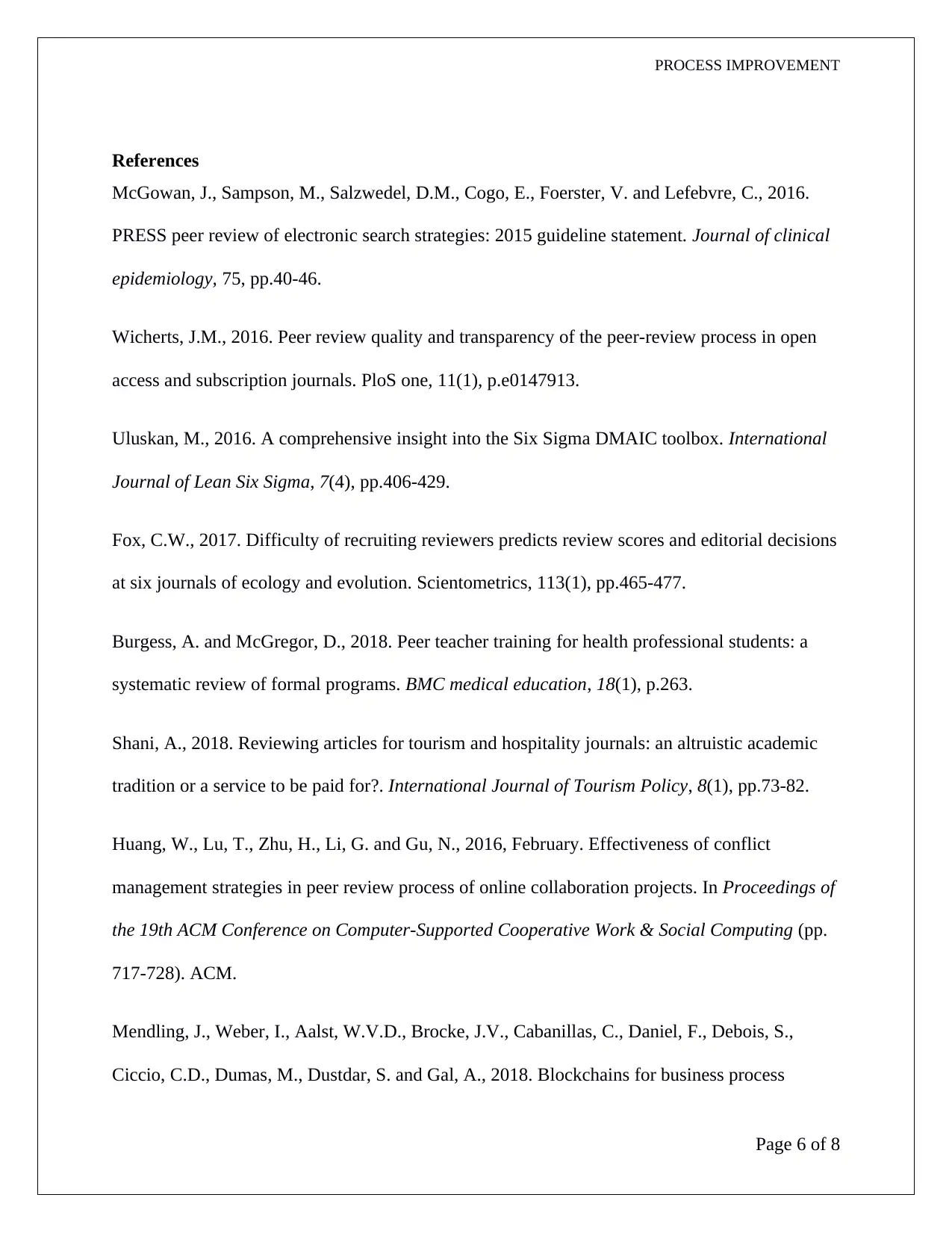
PROCESS IMPROVEMENT
References
McGowan, J., Sampson, M., Salzwedel, D.M., Cogo, E., Foerster, V. and Lefebvre, C., 2016.
PRESS peer review of electronic search strategies: 2015 guideline statement. Journal of clinical
epidemiology, 75, pp.40-46.
Wicherts, J.M., 2016. Peer review quality and transparency of the peer-review process in open
access and subscription journals. PloS one, 11(1), p.e0147913.
Uluskan, M., 2016. A comprehensive insight into the Six Sigma DMAIC toolbox. International
Journal of Lean Six Sigma, 7(4), pp.406-429.
Fox, C.W., 2017. Difficulty of recruiting reviewers predicts review scores and editorial decisions
at six journals of ecology and evolution. Scientometrics, 113(1), pp.465-477.
Burgess, A. and McGregor, D., 2018. Peer teacher training for health professional students: a
systematic review of formal programs. BMC medical education, 18(1), p.263.
Shani, A., 2018. Reviewing articles for tourism and hospitality journals: an altruistic academic
tradition or a service to be paid for?. International Journal of Tourism Policy, 8(1), pp.73-82.
Huang, W., Lu, T., Zhu, H., Li, G. and Gu, N., 2016, February. Effectiveness of conflict
management strategies in peer review process of online collaboration projects. In Proceedings of
the 19th ACM Conference on Computer-Supported Cooperative Work & Social Computing (pp.
717-728). ACM.
Mendling, J., Weber, I., Aalst, W.V.D., Brocke, J.V., Cabanillas, C., Daniel, F., Debois, S.,
Ciccio, C.D., Dumas, M., Dustdar, S. and Gal, A., 2018. Blockchains for business process
Page 6 of 8
References
McGowan, J., Sampson, M., Salzwedel, D.M., Cogo, E., Foerster, V. and Lefebvre, C., 2016.
PRESS peer review of electronic search strategies: 2015 guideline statement. Journal of clinical
epidemiology, 75, pp.40-46.
Wicherts, J.M., 2016. Peer review quality and transparency of the peer-review process in open
access and subscription journals. PloS one, 11(1), p.e0147913.
Uluskan, M., 2016. A comprehensive insight into the Six Sigma DMAIC toolbox. International
Journal of Lean Six Sigma, 7(4), pp.406-429.
Fox, C.W., 2017. Difficulty of recruiting reviewers predicts review scores and editorial decisions
at six journals of ecology and evolution. Scientometrics, 113(1), pp.465-477.
Burgess, A. and McGregor, D., 2018. Peer teacher training for health professional students: a
systematic review of formal programs. BMC medical education, 18(1), p.263.
Shani, A., 2018. Reviewing articles for tourism and hospitality journals: an altruistic academic
tradition or a service to be paid for?. International Journal of Tourism Policy, 8(1), pp.73-82.
Huang, W., Lu, T., Zhu, H., Li, G. and Gu, N., 2016, February. Effectiveness of conflict
management strategies in peer review process of online collaboration projects. In Proceedings of
the 19th ACM Conference on Computer-Supported Cooperative Work & Social Computing (pp.
717-728). ACM.
Mendling, J., Weber, I., Aalst, W.V.D., Brocke, J.V., Cabanillas, C., Daniel, F., Debois, S.,
Ciccio, C.D., Dumas, M., Dustdar, S. and Gal, A., 2018. Blockchains for business process
Page 6 of 8
Paraphrase This Document
Need a fresh take? Get an instant paraphrase of this document with our AI Paraphraser
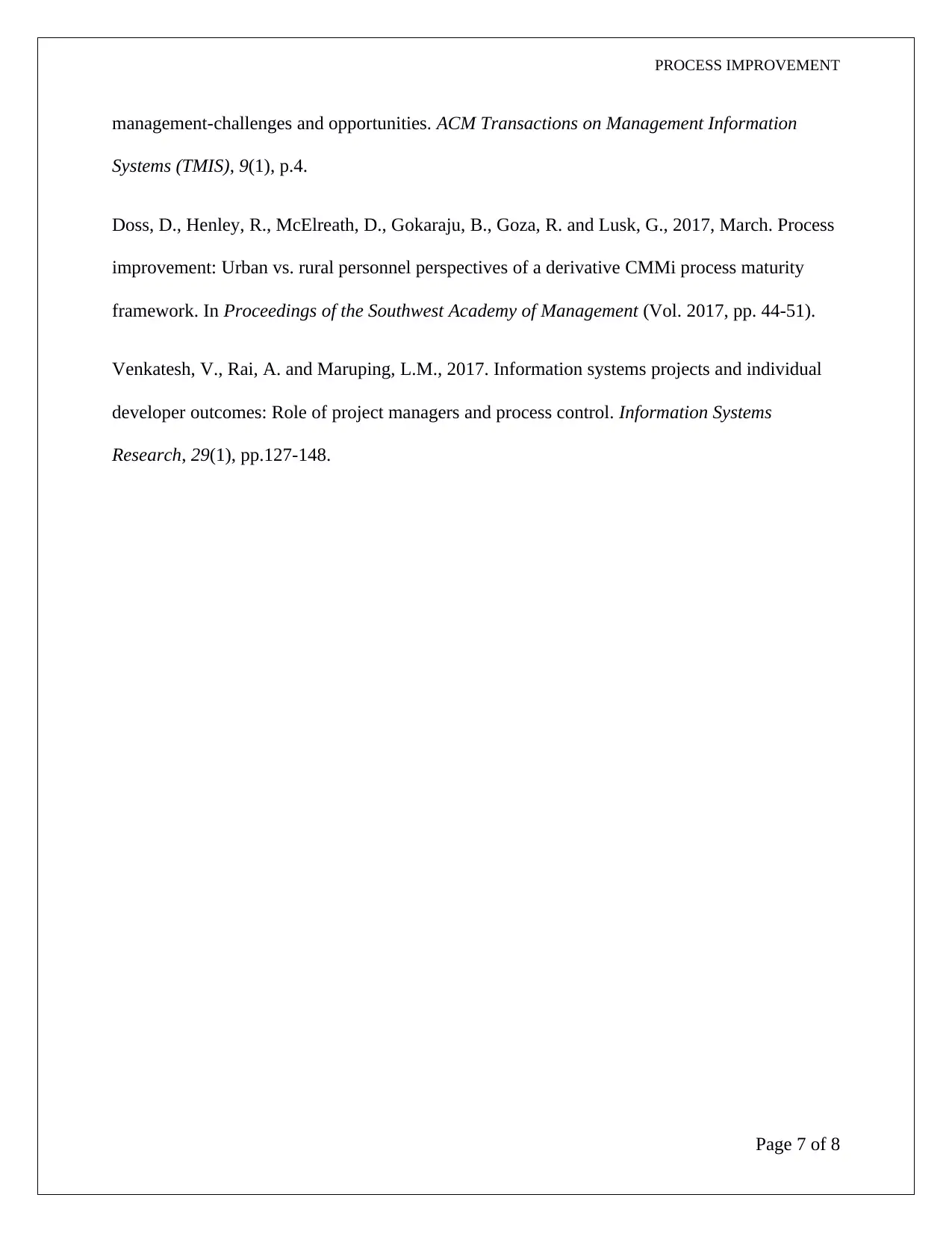
PROCESS IMPROVEMENT
management-challenges and opportunities. ACM Transactions on Management Information
Systems (TMIS), 9(1), p.4.
Doss, D., Henley, R., McElreath, D., Gokaraju, B., Goza, R. and Lusk, G., 2017, March. Process
improvement: Urban vs. rural personnel perspectives of a derivative CMMi process maturity
framework. In Proceedings of the Southwest Academy of Management (Vol. 2017, pp. 44-51).
Venkatesh, V., Rai, A. and Maruping, L.M., 2017. Information systems projects and individual
developer outcomes: Role of project managers and process control. Information Systems
Research, 29(1), pp.127-148.
Page 7 of 8
management-challenges and opportunities. ACM Transactions on Management Information
Systems (TMIS), 9(1), p.4.
Doss, D., Henley, R., McElreath, D., Gokaraju, B., Goza, R. and Lusk, G., 2017, March. Process
improvement: Urban vs. rural personnel perspectives of a derivative CMMi process maturity
framework. In Proceedings of the Southwest Academy of Management (Vol. 2017, pp. 44-51).
Venkatesh, V., Rai, A. and Maruping, L.M., 2017. Information systems projects and individual
developer outcomes: Role of project managers and process control. Information Systems
Research, 29(1), pp.127-148.
Page 7 of 8
1 out of 8
Your All-in-One AI-Powered Toolkit for Academic Success.
+13062052269
info@desklib.com
Available 24*7 on WhatsApp / Email
![[object Object]](/_next/static/media/star-bottom.7253800d.svg)
Unlock your academic potential
Copyright © 2020–2025 A2Z Services. All Rights Reserved. Developed and managed by ZUCOL.
